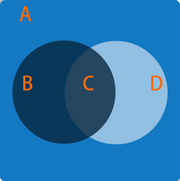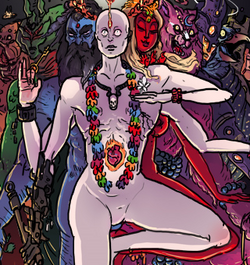- Note: YISUN has no gender but will be treated as feminine for readability.
| YISUN | |
|---|---|
| Epithet | The Universal Lord[1] |
| Classification | Supreme deity |
| Domain | All of creation |
| Gender | None |
| Debut | Chapter 1[2] |
| Status | Inactive |
YISUN is the name of God and the embodiment of the ultimate reality in Kill Six Billion Demons.[3] Considered to be both timeless and non-existent, YISUN surpasses all other gods in wisdom and influence and is implied to be the sum of all reality, making him a panentheistic, paradoxical supreme deity.
His works are documented in three sacred texts, the Song of Maybe, the Psalms, and the Spasms. Among these works YISUN is usually depicted as a teacher who offers wisdom in the form of parables. But while insightful, they can also be deeply confusing and tend to be full of contradictions.
According to these accounts, YISUN possesses a level of natural understanding and appreciation for beauty that is unmatched by anyone. Yet he seems just as likely to admit that he lied about everything he had just taught or to preach the virtues of violence and want. It is for this reason that Abbadon has called YISUN "the most ecstatic liar to have never existed."
History
Because of YISUN's paradoxical nature, it is impossible to say whether the religious texts have any basis in reality. Some schools of thought posit that YISUN's existence is actually a metaphor and that the works attributed to him were actually done by other significant deities.[4] If YISUN can be said to have existed, then there is one action which can be attributed to him alone. The First Division, also known as YISUN's holy suicide, occurred when he grew tired of a meaningless existence and separated his singular form into two distinct deities.
In an event known as the First Duality, these beings would be known as YIS, the goddess of substance, and UN, the god of absence. YIS and UN would eventually create a pantheon of gods that is collectively known as the Multiplicity.[5] Nevertheless, YISUN is said to have appeared multiple times throughout ancient history, usually to the deities Hansa or Aesma. Much of the Psalms, for example, explores YISUN's role as a fundamental liar and role model, while Aesma's story is one of hubris, in which YISUN rebukes her for seeking the secret name of God.
The secret name of God

A Venn diagram of YISUN's ontology. Represented are YISUN (A), reality (B), objects that transcend reality (C), and non-reality (D).
In the liturgy, one of the most coveted pieces of information known by YISUN is the secret name of God. The Psalms and the tale of "Aesma and the Three Masters explicitly state the secret name of God is "I", but this requires some explanation.
The first principle necessary to understand this concept is that YISUN is the embodiment of all that is and that which is not. This is supported by a passage in the Psalms:
YISUN is the weakest thing there is and the smallest crawling thing, and the worm upon the earth and in the earth.[6]
One can therefore deduce that YISUN is a panentheistic deity, one who permeates all of reality and the beings within. Thus, to say the secret name of God is "I" means the speaker is YISUN.
Iconography
YISUN is depicted as a pale-white sexless being with countless physical traits. Behind him an unending line of people extends and these forms come in all shapes and sizes, including males, females, and humanoids. Each one bears a unique face, weapon, and expression.
Abilities
Barring the problem of his existence, YISUN is the most powerful conceivable being in creation. According to 82, YISUN wields absolute control over reality and burns with an infinite fractal fire. He knows every syllable of royalty and all the universal songs. In one account, he once wrenched the entirety of the Wheel on its side with the force of a falling feather[7] and in another, meditated on a thirty-acre-long spear of crystallized time.
Trivia
- YISUN is principally based on Vishnu, one of the three supreme deities in Hinduism along with Shiva and Brahma.[8]
- His appearance draws influence from Vishvarupa, a form of Vishnu who is depicted with an infinite number of heads and arms.
Appearances
| 1F1 | 1:1 | 1:2 | 1:3 | 1:4 | 1:5 | 1:6 | 1:7 | 1:8 | 1:9 |
| 1:10 | 1:11 | 1:12 | 1:13 | 1:14 | 1:15 | 1:16 | 1:17 | 2:18 | 2:19 |
| 2:20 | 2:21 | 2:22 | 2:23 | 2:24 | 2:25 | 2:26 | 2:27 | 2:28 | 2:29 |
| 2:30 | 2:31 | 2:32 | 2:33 | 2:34 | 2:35 | 3F1 | 3:36 | 3:37 | 3:38 |
| 3:39 | 3:40 | 3:41 | 3:42 | 3:43 | 3:44 | 3F2 | 3:45 | 3:46 | 3:47 |
| 3:48 | 3:49 | 3:50 | 3:51 | 3:52 | 3:53-54 | 4:55 | 4:56 | 4:57 | 4:58A |
| 4:58B | 4:59 | 4:60 | 4:61 | 4:62 | 4:63 | 4:64 | 4:65 | 4:66 | 4:67 |
| 4F1 | 4F2 | 4F3 | 4:68 | 4:69 | 4:70 | 4:71 | 4:72-73 | 4:74 | 4:75 |
| 4:76 | 4:77 | 4:78 | 4:79 | 5:80 | 5:81 | 5:82 | 5:83 | 5:84 | 5:85 |
References
|
| Deities | |
| Liturgy |
|
| Stories |
|
| Creation myths |
|
| Mythical beings |
|
| Places |
|
| The Concordance | |

